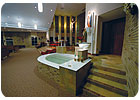
Photo by Peter J. Cardello
A recent renovation of St. Joseph Catholic Church in Strongsville, OH, included building a new baptismal font, which featured Statuary White Carrara marble.
A recent renovation of St. Joseph Catholic Church in Strongsville, OH, included building a new baptismal font, which featured Statuary White Carrara marble.
As a parishioner at St. Joseph Catholic Church in Strongsville, OH, Marc Bittinger’s architectural skills became an asset when the Church wanted to launch a revitalization project. Bittinger, who is a member of the American Institute of Architects (AIA) and works for CBLH Design in Cleveland, OH, was encouraged by his parish priest to join the renovation committee. In the end, the renovation involved redesigning the altar using the original slab of Carrara Statuary White marble that had been used for the previous one as well as utilizing a similar white marble in the construction of a new ambo, chair for the deacon and baptismal font.
“The way it started for me was fun,” said Bittinger. “I was in a church group meeting and the priest was going through things for next year. He said that he was forming a renovation committee, and then he said, ‘Marc, you are going to be on it.’”
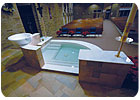
Photo by Peter J. Cardello
The Italian white marble was chosen for the tops of the baptismal font to match the original slab of Carrara marble that forms the top of the altar.
The Italian white marble was chosen for the tops of the baptismal font to match the original slab of Carrara marble that forms the top of the altar.
Another issue was that the church needed to be made ADA accessible. “We had to build a ramp somewhere,” said Bittinger. “It ended up in the chapel so that it wouldn’t affect the look of the church interior.”
According to the architect, the most challenging aspect of the renovation was moving the altar. “The existing altar was made all out of Statuary White Carrara marble,” he said. “It was a beautiful piece. The top was over 12 feet long by 4 feet wide - all one piece. There were also four steps that were made all out of marble.”
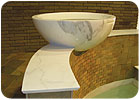
Photo by Peter J. Cardello
The bowl of the baptismal font was custom cut in Italy out of one piece of marble, taking about a month to complete.
The bowl of the baptismal font was custom cut in Italy out of one piece of marble, taking about a month to complete.
“The goal was to move the altar forward and to not have all these steps,” said the architect. “This was a big issue with the congregation that had been there a long time. We were going to disrupt that altar, and they didn’t want to change it.”
“We were trying to do things to make the look of the church more intimate and approachable,” Bittinger continued. “Father John [Micelli], our assistant parish priest, was very helpful in the design. His big thing was that there are two meanings to the altar: ‘altar of sacrifice’ and ‘table of meal.’ We had the ‘altar of sacrifice’ - the slab of marble - but it didn’t look like a ‘table of meal.’ Now we added four wooden legs.”
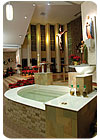
Photo by Peter J. Cardello
“We were trying to do things to make the look of the church more intimate and approachable,” said architect Marc Bittinger of CBLH Design in Cleveland, OH.
“We were trying to do things to make the look of the church more intimate and approachable,” said architect Marc Bittinger of CBLH Design in Cleveland, OH.
Bittinger explained that there are three components of the Catholic Church - the altar, ambo and chair. Part of the renovation project entailed designing a chair and ambo that matched the new design for the altar.
“We designed the ambo with a top that is similar to the top of the altar,” he said. “The vertical marble inlay matches the vertical inlay in the chair.” According to the architect, stone, wood and some metal were utilized in the designs of all three pieces.
For the new baptismal font, a 2.5 x 3.5-foot bowl was custom cut in Italy out of one piece of marble. It took the fabricator, Erasmo Pacini of LINK srl, about a month to complete the job.
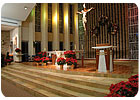
Photo by Peter J. Cardello
The original altar had been set far back from the pews where parishioners sit. When the church was first built, the altar actually faced away from the congregation. It was later turned around, but this set it back even further. One of the goals of the renovation was to move the altar forward.
The original altar had been set far back from the pews where parishioners sit. When the church was first built, the altar actually faced away from the congregation. It was later turned around, but this set it back even further. One of the goals of the renovation was to move the altar forward.
“It was a problem matching the new marble with the existing altar piece,” said Bittinger. “The altar is all white with very little gray. The pieces we saw did have some amount of gray in it. We went to a distributor and took our priest and deacon with us to look at some sheets, and we matched up the pieces. For the bowl, we had to trust that they would match it.”
Complementing the white marble is porcelain tile that resembles the look of slate, which was used for the steps leading to the altar. To add an accent, brown porcelain tiles were used at the edges of the steps. While budget did play a factor in choosing the porcelain, Bittinger also said that the committee liked the slip-resistant quality of the material.

Photo by Peter J. Cardello
“We designed the ambo with a top that is similar to the top of the altar,” said the architect, adding that the ambo also features vertical marble inlays.
“We designed the ambo with a top that is similar to the top of the altar,” said the architect, adding that the ambo also features vertical marble inlays.
Overcoming obstacles
According to Thad Vasko, Manager of CM Services at Infinity Construction Co. of Warrensville Heights, OH, the contractor for the project, one of the more challenging aspects of the job was working while the church remained open for services. “There’s a lot to renovating a church that stayed open,” he said. “We had to keep it operational.”Vasko explained that tearing out the original concrete steps was a large undertaking. “We even had to cut out structural concrete,” said the construction manager, who worked on the job with Project Superintendent Chris Zidek, also of Infinity Construction Co. “We did all of the work during the week and poured the [new] concrete so that it would be ready for Sunday Mass.”
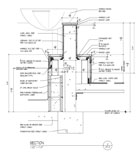
Many technical considerations had to be taken into account for the design and construction of the baptismal font.
On average, there were about six or seven workers on the jobsite each day, with up to 10 or 12 at its peak. The renovation of St. Joseph Catholic Church was completed in under a year, according to the architect, who added that it was finished in time for the Church’s 40th anniversary. To the satisfaction of all those involved, the tile portion of the renovation won the 49th Annual Craftsmanship Awards by The Builder Exchange.
“Everyone was very pleased with it,” said Moore. “It turned out great. It’s hard to remember the day-to-day struggles we went through.”
St. Joseph Catholic Church
Strongsville, OH
Architect:CBLH Design, Inc., Cleveland, OHGeneral Contractor:Infinity Construction Co., Inc., Warrensville Heights, OH
Stone Supplier:Universal Marble & Granite Inc., Cleveland, OH
Stone Fabricators:Martina Marble, Cleveland, OH (marble slabs); LINK srl, Italy (baptismal font marble bowl)
Stone & Tile Installer:Commercial Tile & Stone, Inc., Cleveland, OH
